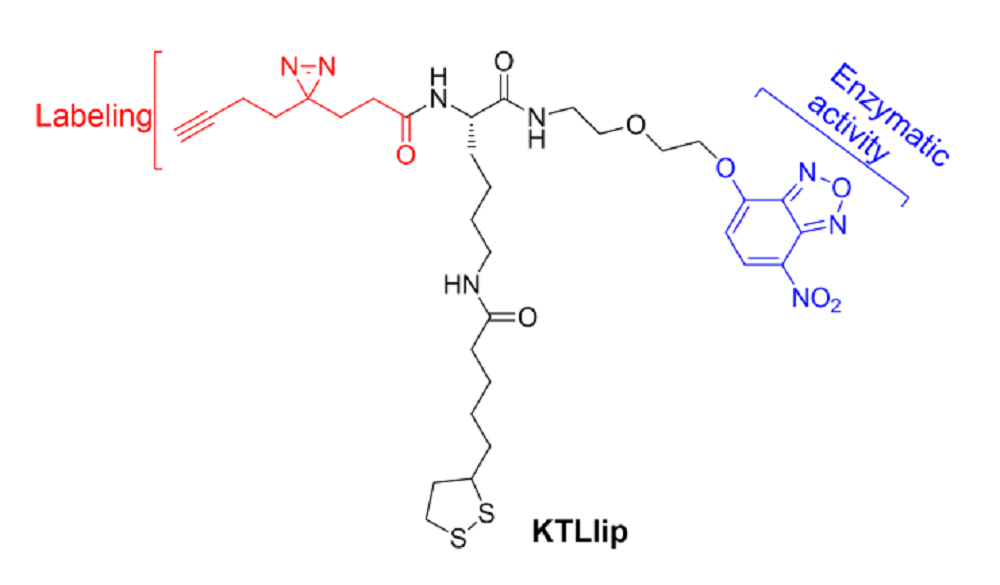To obtain KTLlip, we designed a synthetic scheme, which was illustrated in Scheme 1(b). The photo-cross-linker was synthesized as described before [
23,
24]. The synthesis commenced with a commercially available material, Boc-Lys-OH. Selective protection at
ε-amino group of lysine with the fluorenylmethoxycarbonyl protecting group (Fmoc) was conducted to yield
1. Following coupling reaction using an aminoethoxyl linker and further deprotection of Fmoc,
3 was obtained with 75% yield. By using lipoic acid for functionalization,
4 was generated. The intermediate
5 underwent coupling with a photo-cross-linker and further nucleophilic substitution of NBD-F to afford KTLlip. The chemical structure of final probe was determined unambiguously using NMR and mass spectrometry.
EDCI (150 mg, 0.78 mmol) and HOBt (97 mg, 0.72 mmol) were added to a solution of photo-crosslinker (100 mg, 0.6 mmol) in anhydrous DCM (6 mL), and the mixture was stirred for 1.5 h at room temperature. After activation, a solution of compound 5 (303 mg, 0.72 mmol) with DIEA (233 mg, 1.8 mmol) in dry DMF (2 mL) were then added, and the residues were stirred overnight furtherly. After completion of the reaction and solvent removal under reduced pressure, the residue was purified by flash chromatography (DCM/MeOH, 100/1-15/1) to afford the product 6 (89 mg, 26% yield). 1H-NMR (300 MHz, CD3 OD, δppm): 4.29-4.23 (m, 1H), 3.66 (t, J = 4.2 Hz, 2H), 3.61-3.51 (m, 5H), 3.43-3.36 (m, 2H), 3.21-2.97 (m, 4H), 2.50-2.40 (m, 1H), 2.35-1.98 (m, 7H), 1.93-1.82 (m, 1H), 1.77-1.24 (m, 16H). 13C NMR (CD3OD, 75 MHz, δppm): 176.08, 174.54, 174.48, 83.76, 73.52, 70.53, 70.49, 62.32, 58.90, 57.67, 54.91, 41.43, 40.53, 40.10, 39.46, 37.08, 35.84, 33.45, 32.85, 30.89, 30.20, 29.99, 29.78, 26.90, 24.31, 13.96. ESI-MS calcd for [M+ H]+ 570.27; Found 570.1.
(2S)-6-(5-(1,2-Dithiolan-3-yl)pentanamido)-2-(3-(3-(but-3-yn-1-yl)-3H-diazirin-3-yl)propanamido)-N-(2-(2-((7-nitrobenzo[c][1,2,5]oxadiazol-4-yl)oxy)ethoxy)ethyl)hexanamide (KTLlip). NBD-F (11 mg, 0.06 mmol) and N,N-Diisopropylethylamine (16 mg, 0.12 mmol) were added to a solution of 6 (15 mg, 0.03 mmol) in anhydrous DCM/DMF (3:1). The mixture was stirred and monitored with TLC at room temperature. After completion of the reaction and solvent removal under reduced pressure, the residue was purified by flash column chromatography (DCM/MeOH, 50/1-15/1), followed by preparative TLC, to afford the final product KTLlip as a yellow solid (2.5 mg, 13% yield). 1H-NMR (300 MHz, CD3 OD, δppm): 8.63 (d, J = 8.4 Hz, 1H), 6.92 (m, J = 8.4 Hz, 1H), 6.78-6.70 (m, 2H), 6.38 (br, 1H), 4.53 (t, J = 4.5 Hz, 2H), 4.16-4.08 (m, 1H), 3.91 (t, J = 4.5 Hz, 2H), 3.63-3.55 (m, 3H), 3.36-3.30 (m, 2H), 3.22-3.02 (m, 4H), 2.49-2.39 (m, 1H), 2.15-1.97 (m, 7H), 1.89-1.82 (m, 1H), 1.74-1.36 (m, 16H). 13C NMR (CD3OD, 75 MHz, δppm): 174.43, 173.31, 172.86, 156.01, 147.11, 145.82, 136.78, 131.87, 107.21, 84.40, 72.06, 71.75, 70.75, 70.41, 69.57, 57.77, 54.68, 41.45, 40.07, 39.63, 39.50, 37.07, 35.71, 33.18, 32.46, 30.91, 30.19, 29.91, 29.44, 26.65, 23.72, 14.08. ESI-MS calcd for [M+ H]+ 733.27; Found 733.40.







